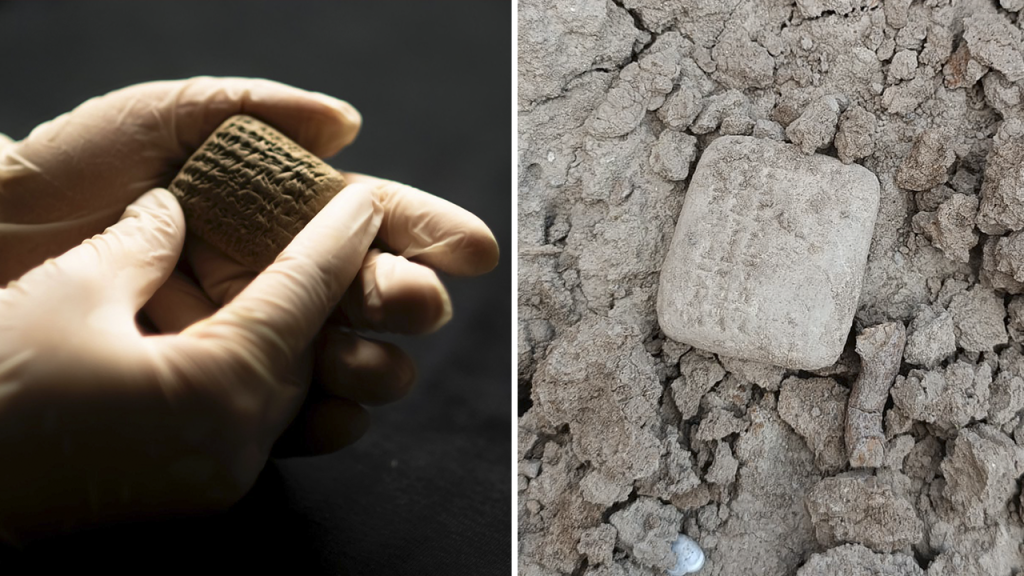Archaeologists working on earthquake restoration in Turkey made a significant discovery – a 15th-century BC Akkadian cuneiform tablet. The tablet, found in Aççana Höyük, also known as Eski Alalah, contains an administrative record detailing a sizable furniture purchase. Cuneiform is a unique form of writing that uses characters impressed on clay to spell out words syllabically. The tablet, measuring 4.2 by 3.5 centimeters and 1.6 centimeters thick, records the purchase of wooden tables, chairs, and stools. The Minister of Culture and Tourism of the Republic of Turkey, Mehmet Nuri Ersoy, believes that this find will provide insights into the economic and state structures of the Late Bronze Age.
The discovery of the Akkadian cuneiform tablet in Turkey sheds light on the purchasing practices and administrative systems of the 15th-century BC. The tablet is a form of written documentation that detailed the acquisition of a significant amount of furniture, including tables, chairs, and stools. This find is expected to offer a fresh perspective on the economic structure and state system of the Late Bronze Age. Linguists are currently analyzing the tablet to determine the specifics of the furniture purchase, such as the quantity of items bought and the identities of the buyers. The Ministry of Culture and Tourism of the Republic of Turkey is involved in further research and analysis of this artifact.
The Akkadian cuneiform tablet discovered in Aççana Höyük, Turkey, highlights the importance of archaeological excavations in uncovering ancient records and artifacts. Cuneiform writing, unlike alphabetical writing, uses characters impressed on clay to form words through syllables. The tablet contains valuable information about the furniture purchasing practices of the 15th-century BC, offering researchers insights into the economic and state structures of that era. The Minister of Culture and Tourism of the Republic of Turkey has expressed enthusiasm about the potential of this find to enhance our understanding of the Late Bronze Age.
The 15th-century BC Akkadian cuneiform tablet found in Turkey adds to the growing collection of historical artifacts that provide glimpses into the past. This tablet, inscribed with an administrative record of a furniture purchase, is a testament to the advanced administrative systems and record-keeping practices of ancient civilizations. The Minister of Culture and Tourism of the Republic of Turkey anticipates that further analysis of this find will deepen our knowledge of the Late Bronze Age and enrich our understanding of economic and state structures from that period. The preservation and study of such archaeological discoveries are vital for unraveling the mysteries of our past.
Cuneiform writing, as seen on the Akkadian tablet unearthed in Turkey, is a fascinating form of communication that differs from alphabetical writing. The use of characters impressed on clay to create syllabic words showcases the ingenuity and complexity of ancient writing systems. The discovery of this tablet, detailing a furniture purchase from the 15th-century BC, presents an opportunity for researchers to delve into the economic and state systems of the Late Bronze Age. By analyzing and interpreting such artifacts, experts can piece together a more comprehensive picture of ancient civilizations and their societal structures.
The Akkadian cuneiform tablet discovered during earthquake restoration work in Turkey is a valuable addition to the archaeological record, shedding light on ancient administrative practices and economic transactions. This relic, inscribed with details of a furniture purchase, holds the potential to enhance our understanding of the Late Bronze Age and provide insights into the economic and state structures of that era. The ongoing research and analysis of this tablet by linguists and archaeologists will contribute to our knowledge of ancient civilizations and their everyday activities. The significance of such discoveries lies in their ability to bridge the gap between the past and the present, offering a glimpse into the lives of our predecessors and the complexity of their societies.













